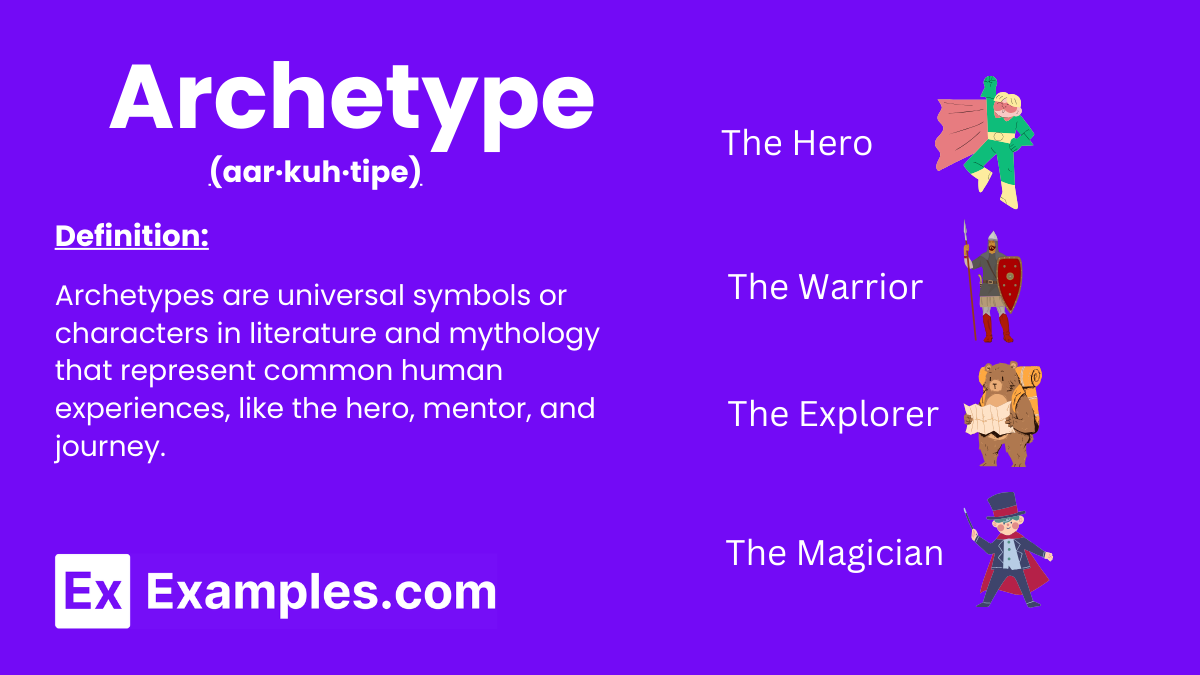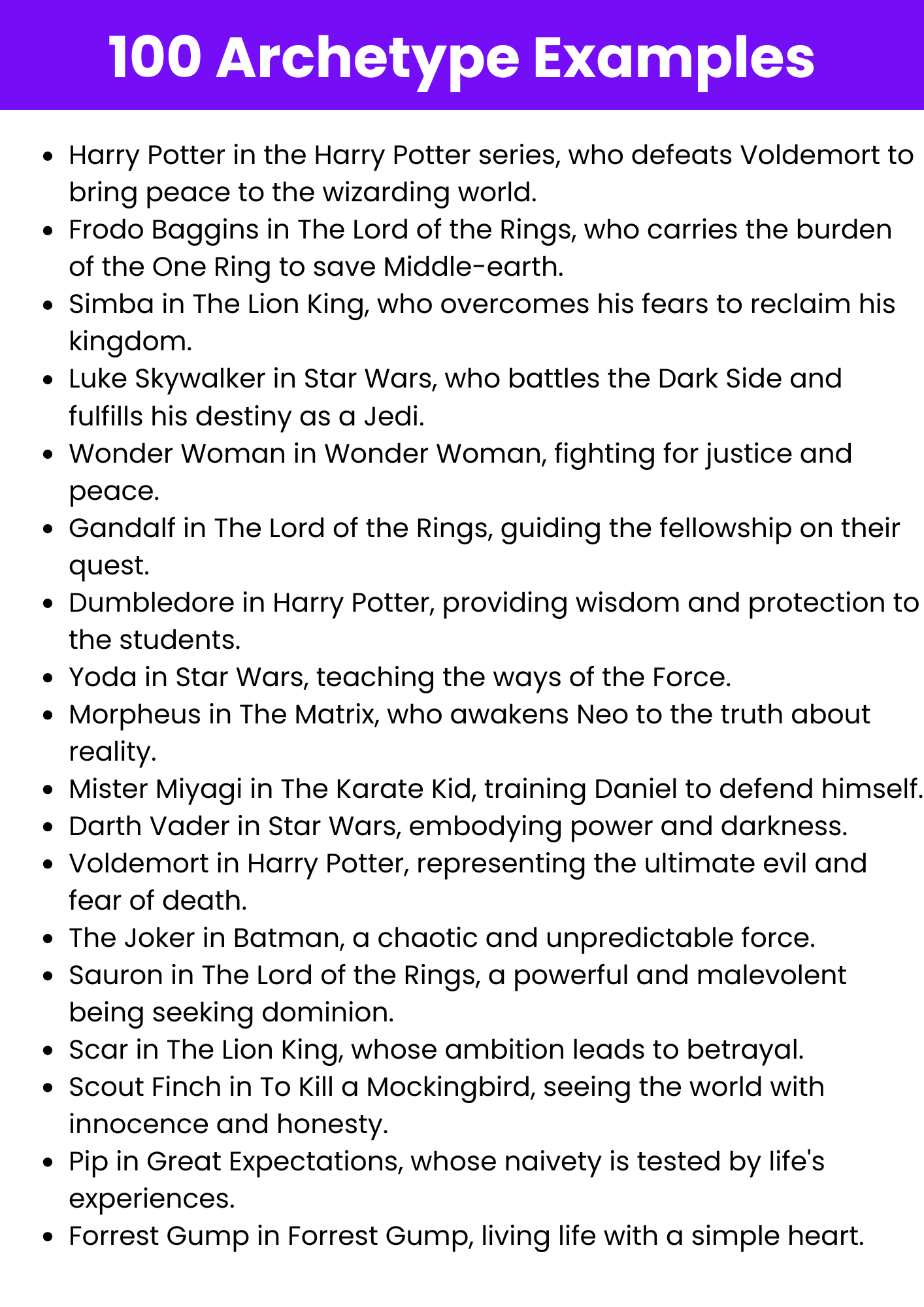Archetype
What is Archetype? – Definition
An archetype is a universally understood symbol, term, or pattern of behavior that recurs across different cultures and literature. Archetypes represent fundamental human experiences and emotions, serving as a blueprint for character development, themes, and narratives.

Generated Archetype Examples

Download Archetype Examples
Enhance your understanding with our comprehensive PDF guide.
Download PDFExamples of Archetypes
- The Hero: Embodies courage and the will to overcome challenges.
- The Mentor: Provides guidance and wisdom to the protagonist.
- The Innocent: Represents purity and optimism, often seeking happiness.
- The Shadow: Embodies the darker aspects of a character’s personality.
- The Ally: Supports and assists the protagonist on their journey.
- The Trickster: Challenges the status quo with humor and unconventional methods.
- The Ruler: Seeks control and order, often holding authority.
- The Caregiver: Provides support and nurturance to others.
- The Sage: Represents wisdom and knowledge, offering insight.
- The Explorer: Seeks adventure and discovery, pushing boundaries.
- The Rebel: Challenges authority and seeks to disrupt the norm.
- The Lover: Embodies passion, desire, and emotional connection.
- The Creator: Driven by the desire to innovate and bring new ideas to life.
- The Everyman: Represents the ordinary person, relatable and humble.
- The Magician: Transforms situations and brings about change.
- The Orphan: Represents abandonment and the struggle to find belonging.
- The Sage: Seeks truth and understanding, guiding others with wisdom.
- The Caregiver: Selflessly supports and nurtures others.
- The Ruler: Desires control and order, often in leadership roles.
- The Explorer: Yearns for adventure and discovery, pushing boundaries.
- The Hero: Faces challenges head-on to achieve a greater good.
- The Innocent: Maintains purity and optimism in a corrupt world.
- The Shadow: Represents the hidden fears and desires within a character.
- The Ally: Offers support and assistance to the protagonist’s quest.
- The Trickster: Uses wit and cunning to challenge the status quo.
- The Ruler: Aspires to lead and maintain control over others.
- The Caregiver: Demonstrates compassion and a desire to help others.
- The Sage: Possesses deep knowledge and offers wise counsel.
- The Explorer: Embarks on journeys to discover new horizons.
- The Creator: Innovates and brings fresh ideas into existence.
Types of Archetypes
Standard Archetypes
Commonly recognized archetypes that appear across various cultures and narratives.
- The Hero: Embodies bravery and the quest for a noble goal.
- The Mentor: Guides and advises the protagonist with wisdom.
- The Innocent: Represents purity and optimism, often seeking happiness.
- The Shadow: Embodies the darker aspects of a character’s personality.
- The Ally: Supports and assists the protagonist on their journey.
Implied Archetypes
Archetypes that are suggested indirectly through context and subtext rather than explicitly stated.
- The Storm: Represents turmoil and chaos in the narrative.
- The Labyrinth: Symbolizes complexity and the challenges within a journey.
- The Mirror: Reflects the true nature of a character.
- The Journey: Represents personal growth and transformation.
- The Flame: Symbolizes passion and destruction.
Extended Archetypes
Archetypes that are developed and explored in depth throughout a narrative or across multiple works.
- The Quest: An extended journey that tests the protagonist’s resolve and abilities.
- The Transformation: The protagonist undergoes significant change, reflecting internal growth.
- The Fall: Represents the protagonist’s descent from grace or loss of innocence.
- The Resurrection: Symbolizes renewal and the overcoming of previous challenges.
- The Revelation: Unveils hidden truths that change the course of the narrative.
Dead Archetypes
Archetypes that have become overused and lost their original impact or uniqueness.
- The Damsel in Distress: A female character needing rescue.
- The Wise Old Man: An elderly character dispensing wisdom.
- The Femme Fatale: A mysterious and seductive woman who leads protagonists into danger.
- The Sidekick: A secondary character who assists the main protagonist.
- The Nemesis: The main antagonist opposing the protagonist.
Mixed Archetypes
Archetypes that blend characteristics from multiple archetypal figures, creating complex and multifaceted characters.
- The Anti-Hero: Possesses both heroic and villainous traits.
- The Mentor-Savior: Guides the protagonist while also being instrumental in their salvation.
- The Tragic Hero: A noble protagonist with a fatal flaw leading to their downfall.
- The Shape-Shifter: A character whose motives and allegiances are uncertain.
- The Catalyst: Initiates change or transformation within the narrative.
Absolute Archetypes
Archetypes that are clear, strong, and direct, leaving little room for ambiguity.
- The Hero: Embodies bravery and the quest to overcome evil.
- The Mentor: Provides wisdom and training to the protagonist.
- The Sage: Represents knowledge and insight, guiding others with wisdom.
- The Shadow: Embodies the darker side, hidden fears, and desires.
- The Ally: Provides support, resources, and assistance to the protagonist.
Visual Archetypes
Archetypes that create vivid images or visuals in the viewer’s mind through symbolic representation.
- The labyrinth: Symbolizes a complex journey of self-discovery.
- The phoenix: Represents rebirth and transformation.
- The shield: Symbolizes protection and defense.
- The mountain: Represents a formidable challenge or obstacle.
- The key: Symbolizes access to knowledge or power.
How to Identify/Find Archetype?
To identify archetypes, analyze recurring symbols, characters, and themes that resonate across different stories and cultures. Look for universal patterns that represent fundamental human experiences and emotions.
- Observe recurring character types and their roles in the narrative.
- Identify symbols and motifs that carry deeper meanings.
- Analyze the relationships and dynamics between characters.
- Notice patterns in the storyline and character development.
- Recognize universal themes such as good vs. evil, journey, and transformation.
How to Use Archetype?
Utilize archetypes to build relatable and compelling characters, develop strong themes, and structure your narrative effectively. Archetypes provide a foundation that can be adapted and expanded to create unique and engaging stories.
- Choose archetypes that align with your story’s message and themes.
- Develop characters by adding unique traits and backgrounds to standard archetypes.
- Integrate archetypes into your plot to drive the narrative forward.
- Use archetypes to create tension and conflict through their interactions.
- Adapt archetypes to fit modern contexts and diverse perspectives.
Other Archetype Examples
Archetypes in Daily Life
Daily life is filled with archetypes that help us understand and relate to various roles and experiences.
- The Caregiver: Selflessly supports and nurtures others.
- The Sage: Seeks truth and offers wisdom to others.
- The Leader: Takes charge and inspires others to follow.
- The Innovator: Brings new ideas and creative solutions.
- The Protector: Safeguards and defends those around them.
Archetype Examples for Kids
Introduce children to the enchanting world of kid-friendly archetypes with relatable characters like “the brave knight” or “the wise owl.”
- The Brave Knight: Always ready to protect and face challenges.
- The Wise Owl: Offers guidance and clever solutions.
- The Playful Monkey: Brings joy and fun to every situation.
- The Gentle Giant: Strong yet kind-hearted.
- The Curious Kitten: Always exploring and learning new things.
Archetype Examples for Students
Empower students with archetypes that make learning engaging. Discover how “the diligent scholar” or “the creative thinker” can inspire academic growth.
- The Diligent Scholar: Committed to learning and academic excellence.
- The Creative Thinker: Generates innovative ideas and approaches problems creatively.
- The Team Leader: Takes initiative and leads group projects effectively.
- The Inquisitive Mind: Always asking questions and seeking deeper understanding.
- The Resilient Student: Overcomes challenges and perseveres through difficulties.
Archetype Examples for Poems
Rich and evocative archetypes that enhance the beauty and imagery in poetic language.
- The River: Represents the flow of time and life’s journey.
- The Moon: Symbolizes mystery, change, and femininity.
- The Phoenix: Embodies rebirth and renewal from ashes.
- The Storm: Represents turmoil and emotional upheaval.
- The Garden: Symbolizes growth, beauty, and natural harmony.
Hidden Personification Archetype Examples
Creative archetypes that bring inanimate objects or nature to life by giving them human-like qualities.
- The Moon danced gracefully across the night sky.
- The trees whispered secrets to the wind.
- The sun smiled warmly upon the meadow.
- The river sang a soothing lullaby.
- The mountain stood tall, guarding the valley.
Archetype Examples About a Tree
Descriptive archetypes that depict trees as more than just plants, highlighting their strength, beauty, and presence.
- The tree is a giant umbrella.
- The bark is a warrior’s armor.
- The tree is a silent sentinel.
- The trunk is a sturdy pillar.
- The sap is the tree’s lifeblood.
Archetype Examples About Love
Passionate and expressive archetypes that capture the intensity and essence of love in all its forms.
- Love is a burning flame.
- Love is a rollercoaster ride.
- Love is the glue that binds us.
- Love is a storm, wild and free.
- Love is a garden that needs care.
Explore Other Literary Devices
Elevate Your AP English Preparation
Unlock your potential with our comprehensive AP English exam preparation tools designed to help you excel.
- Extensive Question Bank: Access 900+ exam-like questions for both AP English Language and Literature.
- Expertly Crafted: Questions mirror the structure and difficulty of actual AP exams, ensuring relevant practice.
- Detailed Explanations: Understand your mistakes with clear, concise breakdowns of correct and incorrect answers.
- Personalized Learning: Tailor your study sessions with topic-specific tests and adaptive learning tools.
- Comprehensive Coverage: Master all aspects of the AP English curriculum with extensive guides and resources.
Frequently Asked Questions
-
How many main Archetypes are there?
There are twelve main Archetypes, including The Hero, The Caregiver, The Ruler, The Creator, The Innocent, The Sage, The Magician, The Explorer, The Rebel, The Lover, The Jester, and The Everyman. -
What is the purpose of using Archetypes in storytelling?
Archetypes help create relatable and engaging characters that resonate deeply with audiences by tapping into familiar traits and emotions. -
Can a character embody more than one Archetype?
Yes, a character can show traits of multiple Archetypes throughout a story, especially as they evolve and grow. -
How do Archetypes influence branding?
Brands use Archetypes to connect emotionally with their target audience, establishing a clear and consistent brand personality. -
Can Archetypes be used in marketing?
Yes, businesses use Archetypes to shape their marketing strategies, creating campaigns that resonate with specific emotions and values of their target audience.

